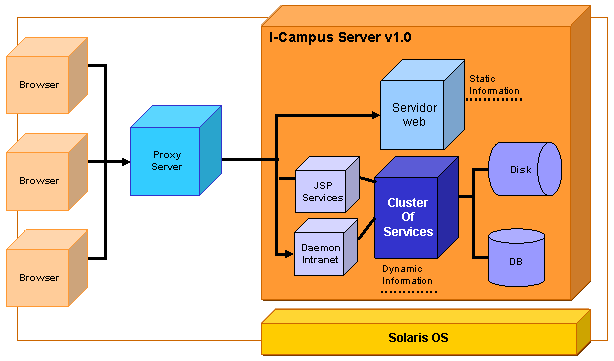|
| |
Architecture of I-Campus
Click on the
image to see more information.

|
|
Browser:
This is an Internet browser.
An example is Netscape or Internet Explorer.
Proxy Server:
This server is in charge of centralising
the traffic between the Internet and the UOC
network, in order to avoid the obligation for the machines
of the UOC to have a direct connection to the Internet.
At the same time, it contains safety mechanisms to impede
any non-authorised external accessThis server is in
charge of centralising the traffic between the Internet
and the UOC network, in order to avoid the obligation
for the machines of the UOC
to have a direct connection to the Internet. At the
same time, it contains safety mechanisms to impede any
non-authorised external access.
Example: One of the machines in
the UOC
network which uses a customer software, like a browser
(Explorer, Netscape...) and needs to visit an Internet
address. As there is no direct connection, the request
is passed on to the proxy server, which will accede
to the page requested and return it to the machine making
the request.
Web Server:
This is in charge of storing and
delivering Web pages. In the case of the Educational
Intranet, it contains the static
pages (they are fixed pages
with a type of content which does not vary).
Analogy: When you go to a video
club in order to borrow a film, at first you can only
take the box. When you are ready to pay for the service,
the person attending you will look for the relevant
cassette in the store-room and give it to you (in an
analogous way, the person and the store-room would be
the static-page server).
Intranet
Daemon : This is the service
managing the Intranet's dynamic
information (in other words,
information subject to variation).
One of the challenges in Internet development
is in the method of executing processes. If a service
is of a CGI*
type, each click a user makes with the mouse generates
a process, and the performance of the hardware, as can
be imagined, becomes very low. The UOC's
Intranet Daemon executes processes by threads (multiple
synchronous executions under a single process sharing
resources such as the memory and data), so that a process
can give rise simultaneously to a great number of clicks
from various users. In memory and data sharing, if a
user needs the same information as another who is part
of the same process, he or she does not need to seek
the information at its source, as it has already been
obtained and is therefore immediately available.
Analogy: Sorting books in a library
Five books enter a library every minute. In the case
of CGI, the librarian waits at the door, collects one
book, goes up the ladder and places the book on the
shelf. With Intranet Daemon, the librarian collects
the five books at the same time, and goes up the ladder
and places them on the shelf in one operation, and takes
advantage of the action of going up the ladder to sort
them all at the same time.
Cluster
of services: this is the
application containing the business rules (all the norms
of an application) of the UOC
Intranet, sorted and organised according to services.
They are accessible and inter-operational by means of
a standard protocol named IIOP,
which is a part of CORBA
(a computing solution open to the connection of applications
on different platforms).
The IIOP
standard can be used from various applications and allows
you to call for a service independently of the visual
design and the business logic applied to it. The cluster
of services allows changes in this business logic without
affecting the use of the Campus, as its architecture
is divided up into services - before, it used to be
monolithic.
Developments have been made in
Java, a programming language which has advantages and
disadvantages. The following are its main advantages:
|
|  |
Easy re-use.
|
|
|  |
Integration into the Internet.
|
|
|  |
Flexible language.
|
|
|  |
Independence from the operating system (as programming
is done through Java's virtual machine).
|
The most important disadvantages are:
|
|  |
Low performance of virtual machines, as little
work has been done on its technology.
|
|
|  |
A young and rapidly-evolving language, which
forces one to adapt oneself to it constantly.
|
Analogy. Let us
imagine a house which we shall name "cluster of
services". Its different rooms -dining-room, kitchen,
dormitories- would constitute the business logic, in
other words, the structure of the house. And the gas
and light services, for example, would be those offered
by the "house" cluster of services. In this
case, we could carry out a renovation of part of the
electrical installation of the whole house without affecting
either its structure (the business logic) or the distribution
of spaces.
|